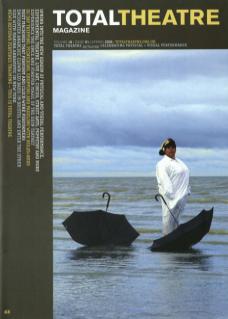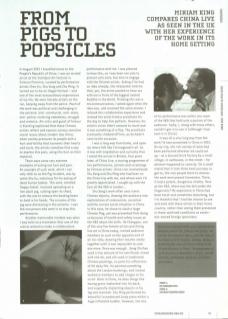In August 2001 I travelled alone to the People's Republic of China. I was an invited artist at the 2nd Open Art Festival in Sichuan Province, curated by performance artists Chen Jin, Shu yang and Zhu Ming. It turned out to be an illegal festival – and one of the most extraordinary experiences of my life. We were literally artists on the run, keeping away from the police. Much of the work was political and challenging in the extreme: anti-communist, anti-state, anti-police; involving nakedness, struggle and violence. Art critic and guest of honour Li Xianting explained that these Chinese artists reflect and express various sensitive social issues about modern day China: when society pressures its people with a hurt and futility that torments their hearts and souls, the artists somehow find a way to express this pain, using this hurt as their material.
There were some very extreme examples of acting out hurt and pain. An example of such work, which I can only refer to as the Pig Incident, was by artist Zhu Yu, notorious for his eating of dead human babies. This work, entitled Happy Easter, involved operating on a live adult pig, cutting open its chest, with the aim to remove the beating heart to hold in his hands. The screams of the pig were distressing in the extreme. I was the one person who went in to stop this performance.
Another memorable incident was when I was told via a translator that one of the artists wished to make a collaborative performance with me. I was pleased to hear this, as I was keen not only to present solo work, but also to engage with the Chinese artists. Asking if he had an idea already, the interpreter told me that, yes, the artist wanted to have sex with me in front of the biggest seated Buddha in the World. Thinking this was a miscommunication, I asked again what the idea was, and received the same answer. I refused this collaborative experience and instead the artist hired a prostitute for the day to help him perform. However, his artistic vision didn't amount to much and it was something of a flop. The prostitute eventually climbed off him, as he hadn't risen to the occasion.
I was a long way from home, and upon my return felt like I'd imagined it all. So it was with trepidation and curiosity that I noted the arrival in Britain, four years later, of China Live, a touring programme of live performances, actions and screenings by Chinese artists. China Live involved both Shu yang and Zhu Ming who had been on the China trip with me, and whose work I'd greatly appreciated. I caught up with the tour at the V&A in London...
Shu Yang's work often uses iconic Chinese objects, drawing the audience into explorations of communism, socialism and the current social situation in China. In this case, he chose to slash a large Chinese flag, yet was prevented from doing so because of health and safety issues at the V&A about the knife. He Chengyao, one of the very few female artists practising live art in China today, invited audience members to suck on the opposite end of an ice-lolly, drawing their mouths slowly together until it was impossible to suck any more. Once was enough. Yang Zhichao used a tiny amount of his own blood, mixed with red ink, and silk used in traditional Chinese paintings, to paint his reflections of UK daily life. He painted something about the London bombings, and invited audience members to add images to his scroll. Back in China, he does things like having grass implanted into his back, and surgically implanting objects in his leg and stomach. Zhu Ming performed his beautiful incandescent body piece within a huge inflatable bubble. However, the site of his performance was within one room of the V&A that held only a portion of the audience. Sadly, I, along with many others, couldn't get in to see it (although I had seen it in China).
It was all a very long way from the work I'd seen presented in China in 2001. On my trip, the rich variety of work had been performed wherever we could set up – at a disused brick factory by a small village, in outhouses, in the street – for whoever happened to come by. On a small island that it took three boat journeys to get to, the only people there to witness the work were peanut harvesters. There, it had a potent, dangerous vitality. Here at the V&A, where was the dirt under the fingernails? My experience in China had been harsh and sometimes disturbing, but I'm thankful that I had the chance to see and work with these artists in their home country, rather than seeing them presented in these sanitised conditions as exotic-but-tamed foreign specimens.
China Live (autumn 2005) was a collaboration between Live Art UK, Chinese Arts Centre, the Live Art Development Agency and Shu Yang of the Dadao Live Art Festival, Beijing, aiming to promoting the work of Chinese Artists in the UK and UK artists in China. The programme of work travelled to Manchester, Bristol, Cardiff, Coventry, Gateshead, Liverpool, Colchester and London.

